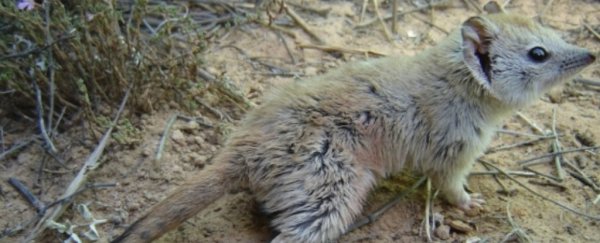A small, adorable-but-deadly carnivorous marsupial thought extinct in the Australian state of New South Wales has been unexpectedly rediscovered.
The crest-tailed mulgara, one of two species of mulgara, still lives in the desert of Central Australia in other states, but now it's been found living in the Sturt National Park, right in the northwest corner of NSW.
Previously, it was known to inhabit the state only through fossilised bone fragments, and it had been thought extinct from the region for over a century.
It's actually quite difficult to determine how many crest-tailed mulgaras remain, and how far it roams across central Australia.
This is because, for many years, the two species of mulgara - the crest-tailed mulgara and its closely related cousin, the brush-tailed mulgara - were thought to be the same species.
 (Reece Pedler/UNSW)
(Reece Pedler/UNSW)
The distinction between the two was only realised in 2005, when genetic testing confirmed that they were two discrete species, with only a few differences.
The crest-tailed mulgara has a crest on its less-bushy tail, and eight nipples to the brush-tailed mulgara's six. They're both of around the same size - up to 30 centimetres (12 inches) from nose to tail, and both have the same sandy-blonde fur.
Nevertheless, the crest-tailed mulgara is listed as vulnerable in the Northern Territory and Queensland, endangered in South Australia, and extinct in New South Wales - a status that will need to be revised.
"The crest-tailed mulgara was once widely distributed across sandy desert environments in inland Australia, but declined due to the effects of rabbits, cats and foxes," said Rebecca West of the University of New South Wales.
She's working with the university's Wild Deserts project to reintroduce locally extinct species to the national park. It was while on a recent scientific monitoring trip that the mulgara was found.
Australia's desert is home to some amazing creatures. Because it's so hot, many are nocturnal, and have evolved to rely as little on water as possible.
Mulgaras dwell in extensive burrow networks under the sand dunes, emerging at night to hunt prey.
They don't need to drink water at all, instead meeting their need for liquid by feasting on the juices found in the animals they eat - small mammals and reptiles, and plump invertebrates such as centipedes and spiders.
When an animal becomes extinct in a region, it indicates that the ecology of that region has significantly changed, such as a new predator moving in, the climate of the habitat no longer being suitable, or insufficient food.
The rediscovery of the mulgara means that perhaps other species extinct in the same area could still thrive.
Wild Deserts is doing just this - and although the crest-tailed mulgara was not on the project's list of animals to reintroduce, the work could also benefit the marsupial.
"The aim of this project is to return mammal species not seen in their natural habitat for over 90 years in Sturt National Park," said National Parks and Wildlife Service area manager Jaymie Norris.
"Rabbits, cats and foxes will be eradicated from two 20-square-kilometre fenced exclosures in Sturt National Park, before locally extinct mammals are reintroduced.
"Reintroduced native mammal species will include greater bilby, burrowing bettong, western quoll and western barred bandicoot."
Removing rabbits will increase the amount of ground cover, and removing non-native feral cats and foxes will remove an unnatural predator that has wreaked havoc on native animal populations Australia-wide.
UNSW Science is a sponsor of ScienceAlert. Find out more about their world-leading research.
